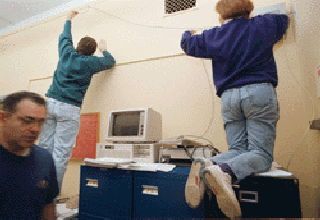 One
of the most controversial issues with the internet is whether or not the
internet should be in schools.
One
of the most controversial issues with the internet is whether or not the
internet should be in schools. Schools and the Internet
PRESIDENT CLINTON'S GOALS
2000
TEACHING THE TEACHERS
STUDENTS USING THE NET
RESOURCES
 One
of the most controversial issues with the internet is whether or not the
internet should be in schools.
One
of the most controversial issues with the internet is whether or not the
internet should be in schools.  President
Clinton has been pushing to get all schools wired by the turn of the century.
As he had stated during his debates
during the election, "And, most important, let's make education
our highest priority so that every eight-year-old will be able to read,
every 12-year-old can log on to the Internet, every 18-year-old can go
to college." As has been shown, the world will be a much more technological
society and to keep up, we need to teach the students of today how to access
the internet and use it as a resource or they will not be prepared for
the future.
President
Clinton has been pushing to get all schools wired by the turn of the century.
As he had stated during his debates
during the election, "And, most important, let's make education
our highest priority so that every eight-year-old will be able to read,
every 12-year-old can log on to the Internet, every 18-year-old can go
to college." As has been shown, the world will be a much more technological
society and to keep up, we need to teach the students of today how to access
the internet and use it as a resource or they will not be prepared for
the future. "Preparing our children for a lifetime of computer use is now just as essential as teaching them to read and write and do math. Every major U.S. Industry has begun to rely heavily on computers and telecommunications to do its work."
The goals the President has outlined are: "(1) Connect every school and classroom in America to the information superhighway; (2) Provide access to modern computers for all teachers and students; (3) Develop effective and engaging software and on-line learning resources as an integral part of the school curriculum; and (4) Provide all teachers the training and support they need to help students learn through computers and the information superhighway." One of the ways he is trying to meet these goals is to foster the cooperative efforts between schools, government and the private sector by the use of The Technology Innovation Challenge Grants which matches each federal dollar by about three dollars from local and private funds. So far some of the CEO's of the biggest companies in this country and some of the smallest in local areas have rallied and contributed resources and their energy to meet the four goals of Our President.
A major problem with trying to get the internet in schools is funding. Without the help of local corporations and organizations, who are most likely to finance or equip local schools, it is almost impossible for some school districts to afford or even finance the purchase of computers, extra telephone lines, maintenance and training of teachers. But without proper training, teachers are not going to be able to guide students through the often confusing maze of Internet features, menus and files.
One aspect that the President is trying to put into place with the help of the FCC, are discounts in the amount of $2.25 million to both poor and rich districts to bring internet access into the schools based on the percentage of students a district has that are eligible for free lunches. This is thanks to the Telecommunications Act of 1996.
Part of the problem with getting internet access into the classroom is getting teachers to actually use it within the class and designing lesson plans around some internet activities. What has been happening currently is that the classes are being wired but the teachers are either not comfortable with computers or just do not know how to effectively use the internet in their classes.
Even the government is pushing for teachers to become technologically prepared to use computers in their teachings. As Secretary Riley brought out in his remarks in the National Forum: Attracting and Preparing Teachers for the 21st Century (April 17, 1997), with today's classrooms being more crowded than ever, our teachers need to be prepared. They need to be skilled in using technology, i.e. computers, in their teachings and we are finding that there needs to be more teachers "well-versed in teaching English as a second language." We need a new model for the 21st century, one that incorporates technology, including the internet. The internet not only helps students, but give teachers a way to talk to teachers in other parts of the country and world.
As stated in Preparing Teachers for Effective and Wise Use of the Internet in Schools:
"Teachers not only need a general knowledge of computers and computer networks, but also need to learn to use email, gopher servers, the file transfer protocol (ftp), and the World Wide Web. If they wish to publish materials on the Web, they need a rudimentary knowledge of standard hypertext markup language (HTML). Teachers also need a sense of the structure of the Internet, of what constitutes acceptable use, and of how other teachers have used it."
Many teachers have said that the internet is the first real set of resources to significantly expand the textbook and library. In Bellwether or Bust? Educators Debate the Value of Surfing, Neil MacFarquhar wrote
"Skeptics think educators need to spend more time weighing the arguments made by huge computer and publishing corporations that making learning more exciting is an improvement. The skeptics say they believe that a decade of computer use in schools has not resulted in any marked improvement in children's learning basic skills. Instead, they say, the Internet will promote a cut-and-paste style of learning, with students parroting trivial bites of information found on the computer screen instead of developing the critical judgment and analysis engendered by culling through books."
One of the reasons that students and teachers like the Web is that they have a wealth of information at their hands without having to pay for it by the minute as with some other on-line databases. "Cyberspace creates options for collaboration as well as for communication." As Jiri Weiss wrote in The Wiring of Our Children,
"...teachers and students are streaming online to research term papers, download software, communicate with scientist and explorers, and to collaborate with classrooms around the world....And textbook and CD-ROM publishers are beginning to publish materials online. A few universities are even reaching out to teach advanced courses to high-schoolers via the Net."
As Ann Johnson wrote in her article The Internet Pyramid for Elementary Students, "the internet is also invaluable for 'visiting the world.' You can't go to Sea World and find out the latest news on Shamu, the Killer Whale, using most books? Books are wonderful, but in today's world we need to teach students a variety of ways to access information in the classroom." But it is not the only thing that should be used in research; books, computers, filmstrips, tape players, and much more can be used.
Many teachers are having their students study various areas of science using the Internet, for example Aeronautics using NASA's project for schools.
A recent study has found that students who use on-line materials in some settings may perform better than those who are not plugged into the Internet. Mendes, Study Shows Value of Wired Classroom.
Citations:
MacFarquhar, Neil; Bellwether or Bust? Educators Debate Value of Surfing,
The New York Times, March 7, 1997
Mendels, Pamela; FCC Moves to Ensure Net Access for Schools,
The New York Times, November 13, 1996
Mendels, Pamela; Study Shows Value of Wired Classroom, The
New York Times, October 26, 1996